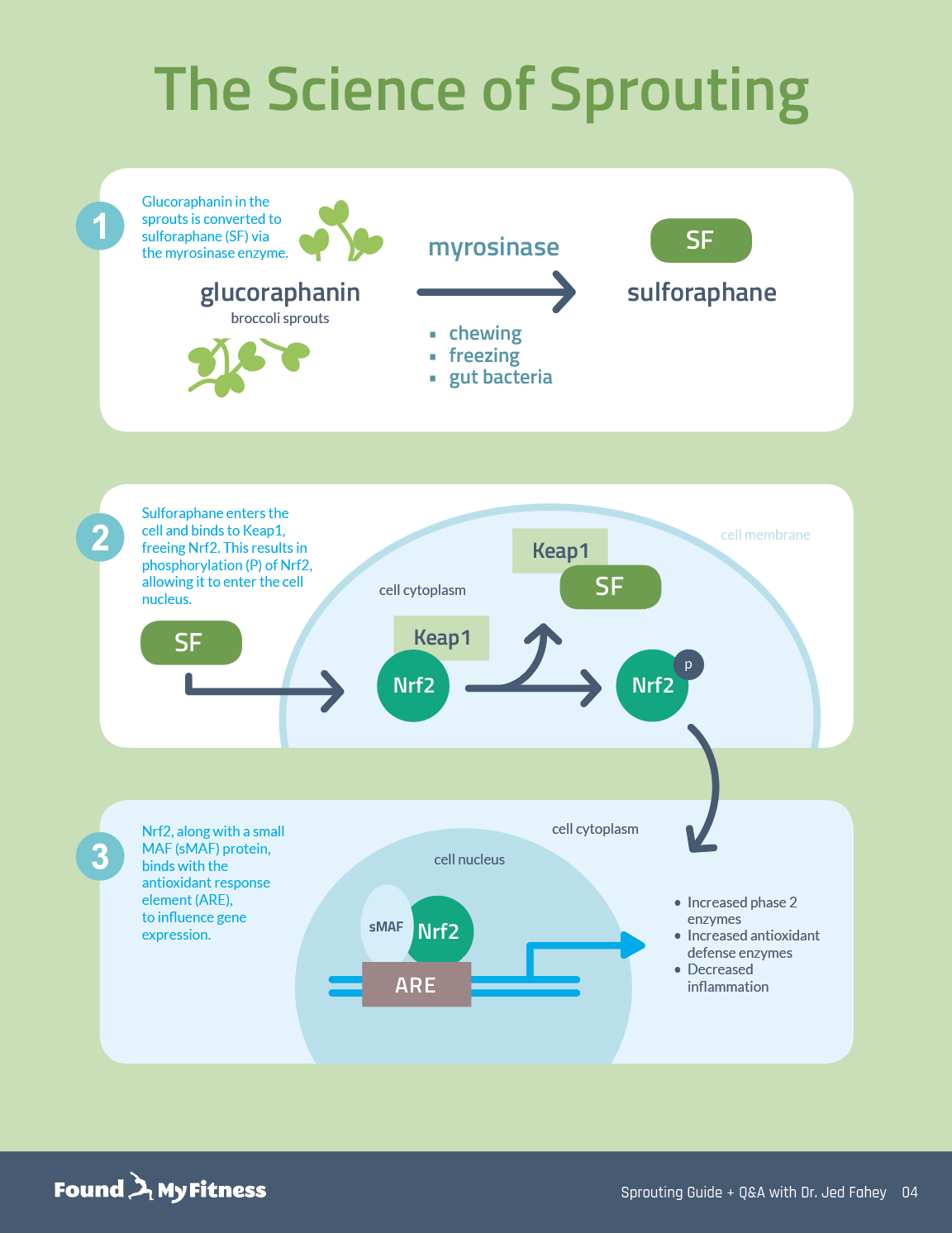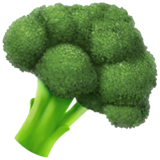Potential benefits of sulforaphane for Alzheimer's disease | Jed Fahey
Enter your email to get our 15-page guide to sprouting broccoli and learn about the science of chemoprotective compount sulforaphane.
Broccoli sprouts are concentrated sources of sulforaphane, a type of isothiocyanate. Damaging broccoli sprouts – when chewing, chopping, or freezing – triggers an enzymatic reaction in the tiny plants that produces sulforaphane.

Get the full length version of this episode as a podcast.
This episode will make a great companion for a long drive.
A growing body of evidence suggests that sulforaphane's protective effects extend to the brain, where it appears to enhance brain-derived neurotrophic factor (a protein that controls and promotes the growth of new neurons) and inhibits histone deacetylation (an epigenetic modification that influences gene expression). Other evidence demonstrates that sulforaphane provides protection from methylglyoxal, a critical player in the pathogenesis of advanced glycation end products, prominent features of diabetes and major contributors to amyloid-beta aggregation in the brain. In this clip, Dr. Jed Fahey discusses the current state of the science regarding sulforaphane and brain health.
[Dr. Patrick]: Let's move on to the next question in the section, which is, "What are your thoughts, if any, on the potential benefits of sulforaphane or even other isothiocyanate activators of NRF2 for Alzheimer's disease? There's been just repeating preclinical evidence that amyloid beta, you know, is decreased and that, you know, isothiocyanates and sulforaphane seem to have a positive effect on Alzheimer's disease."
[Dr. Fahey]: Yeah. So this is a case where I need to give Dr. Patrick's listeners a data dump of papers. There's a huge amount of literature that, you know, would be fun to post links to from animal models and cell culture work. Let me start... Actually, I just found this...or I just rediscovered this this morning. Let me start by citing a clinical study, and then go back to some of the animal study work.
So as all of you know, animals, mostly rats and mice, are used to spare having to do some of these experiments on people. And so what usually happens, what frequently happens, maybe COVID-19 is going to be an exception, but what frequently happens is you have cell culture work, you have...or in vitro work, where you add chemicals to cultured human cells or animal cells in a petri plate, you get positive effect or not, then you move to trials where you, like it or not, sacrifice mice to the cause of science. And if you're lucky enough and there's a rodent model of a disease, you get some results. And then maybe you'll do a preclinical study to verify safety, and then you'll go to a full-fledged clinical study to look at efficacy.
So a lot of animal studies, I'll get back to a few citations, but there is one now, there's one posted clinical trial in China in Zhejiang University. And it will be looking at 160 subjects with early Alzheimer's. And they're going to be giving sulforaphane. It was posted for a start date of sometime in May of 2020, I doubt that's happened because of COVID. Most clinical trials are on pause. I do want to make...
So you can find this on clinicaltrials.gov, that's a website that categorizes all of the U.S.-approved clinical trials and many around the world. You can find it and read about it yourself. If you do that, be careful. Because, you know, I think this may well be a good and interesting study. But when you look at what they're giving, they're giving dietary supplement sulforaphane. And they say they're giving 2,550 milligrams once a day. And half of the people are getting a placebo. I won't go into the math, but that amount is enough to kill a horse. And so that's between 10 and 100, closer to 100, times what I would recommend giving to a person.
So my only guess is that they're talking about the weight, 2.5 grams or 2,500 milligrams, of a supplement tablet. And there's not information on this website that lets us know what they're actually giving patients or how much sulforaphane they'll actually be getting. But, you know, it may well be a very interesting study, so we should keep our eyes on it.
But to go back to the animal work, with a former doctoral student, Anita Panjwani, we did a review a couple of years ago looking at actually all of the neurodegenerative diseases, like Parkinson's and Alzheimer's and Huntington's, and the neurodevelopmental diseases, like autism, and looking at the evidence for sulforaphane. And it's extensive. And, you know, things like HDAC inhibition...histone deacetylase, sorry, inhibition. Enhancement of BDNF, brain-derived neurotrophic factor. Certainly a reduction in amyloid beta. And the list really goes on and on, the things that other people have done. I have not been directly involved in that.
Then there are a couple of reviews from...even more recently from last year, which I'll send to Rhonda, you know, talking about, for example, sulforaphane protecting cultured neural cells from the toxicity of methylglyoxal, which is a precursor of AGEs, or advanced glycation end products, that are very clearly associated with Alzheimer's disease. Models that show reduced neuronal cell death due to amyloid beta exposure due to activation of peroxisomes, these are things that help detoxify.
So they're a very, very long list and just the reviews, the review articles, have pages and pages of evidence. So I will share some of that with Rhonda, but it's very encouraging. 10 years ago we were, Paul Talalay and I, were invited to work with a group in the Netherlands that was going to be a big multicenter Alzheimer's prevention trial using sulforaphane. 10 years ago, or 2011. It was a multimillion-dollar trial. Funding never... I don't know if funding started and stopped, but it never actually happened. And I'm not aware of other Western follow-up studies. As I say, I just found this study in China that is being conducted, I should say, by some researchers who have done some good animal model work and published a bit before, a lot before. So I have high hopes for the China study, but we'll see.
A neurodegenerative disorder characterized by progressive memory loss, spatial disorientation, cognitive dysfunction, and behavioral changes. The pathological hallmarks of Alzheimer's disease include amyloid-beta plaques, tau tangles, and reduced brain glucose uptake. Most cases of Alzheimer's disease do not run in families and are described as "sporadic." The primary risk factor for sporadic Alzheimer's disease is aging, with prevalence roughly doubling every five years after age 65. Roughly one-third of people aged 85 and older have Alzheimer's. The major genetic risk factor for Alzheimer's is a variant in the apolipoprotein E (APOE) gene called APOE4.
A developmental disorder characterized by impaired social interaction, behavioral problems, and poor communication. Autism typically manifests in early childhood and is slightly more common among boys than girls. In clinical trials, sulforaphane, a compound derived from broccoli and broccoli sprouts, reduces the characteristic behaviors associated with autism.
An infectious disease caused by the novel coronavirus SARS-CoV-2. COVID-19, or coronavirus disease 2019, was first identified in Wuhan, China, in late 2019. The disease manifests primarily as a lower respiratory illness, but it can affect multiple organ systems, including the cardiovascular, neurological, gastrointestinal, and renal systems. Symptoms include fever, cough, fatigue, shortness of breath, and loss of smell and taste. Some infected persons, especially children, are asymptomatic. Severe complications of COVID-19 include pneumonia, sepsis, acute respiratory distress syndrome, kidney failure, multiple organ dysfunction syndrome, and cytokine storm. Treatments currently involve symptom management and supportive care. Mortality varies by country and region, but approximately 6 percent of people living in the United States who are diagnosed with COVID-19 expire.[1] 1
A chemical process in which a sugar molecule binds to a protein or lipid molecule. Glycation differs from glycosylation, which is an enzymatic reaction. It occurs in the bloodstream, primarily to the dietary sugars glucose, fructose, and galactose. Fructose is nearly 10 times more likely to be glycated than glucose.[1]
- ^ McPherson, John; Shilton, Brian H.; Walton, Donald J. (1988). Role Of Fructose In Glycation And Cross-Linking Of Proteins Biochemistry 27, 6.
The chief protein components of chromatin found in eukaryotic cell nuclei that package and order the DNA into structural units called nucleosomes acting as spools around which DNA winds, and playing a role in gene regulation.
Experiments that are performed using cells or microorganisms outside of their normal biological context and are often done in a test tube or petri dish.
An essential mineral present in many foods. Iron participates in many physiological functions and is a critical component of hemoglobin. Iron deficiency can cause anemia, fatigue, shortness of breath, and heart arrhythmias.
Byproduct of a reaction between two compounds (glucosinolates and myrosinase) that are found in cruciferous vegetables. Isothiocyanates inhibit phase I biotransformation enzymes, a class of enzymes that transform procarcinogens into their active carcinogenic state. Isothiocyanates activate phase II detoxification enzymes, a class of enzymes that play a protective role against DNA damage caused by reactive oxygen species and carcinogens. Examples of phase II enzymes include UDP-glucuronosyltransferases, sulfotransferases, N-acetyltransferases, glutathione S-transferases, and methyltransferases.
A chemical that causes Parkinson's disease-like symptoms. MPTP undergoes enzymatic modification in the brain to form MPP+, a neurotoxic compound that interrupts the electron transport system of dopaminergic neurons. MPTP is chemically related to rotenone and paraquat, pesticides that can produce parkinsonian features in animals.
A protein typically present in the cytoplasm of mammalian cells. Nrf2 can relocate to the nucleus where it regulates the expression of hundreds of antioxidant and stress response proteins that protect against oxidative damage triggered by injury and inflammation. One of the most well-known naturally-occurring inducers of Nrf2 is sulforaphane, a compound derived from cruciferous vegetables such as broccoli.
A chemical reaction in which an atom, molecule, or ion gains one or more electrons.
An isothiocyanate compound derived from cruciferous vegetables such as broccoli, cauliflower, and mustard. Sulforaphane is produced when the plant is damaged when attacked by insects or eaten by humans. It activates cytoprotective mechanisms within cells in a hormetic-type response. Sulforaphane has demonstrated beneficial effects against several chronic health conditions, including autism, cancer, cardiovascular disease, diabetes, and others.
Pertaining to sustenance. Trophic factors are critical for brain development and may help treat or prevent brain injuries and disorders. Examples include modulators of growth and maintenance, such as insulin and nerve growth factor.
Supporting our work
If you enjoy the fruits of
 , you can participate in helping us to keep improving it. Creating a premium subscription does just that! Plus, we throw in occasional member perks and, more importantly, churn out the best possible content without concerning ourselves with the wishes of any dark overlords.
, you can participate in helping us to keep improving it. Creating a premium subscription does just that! Plus, we throw in occasional member perks and, more importantly, churn out the best possible content without concerning ourselves with the wishes of any dark overlords.





































































